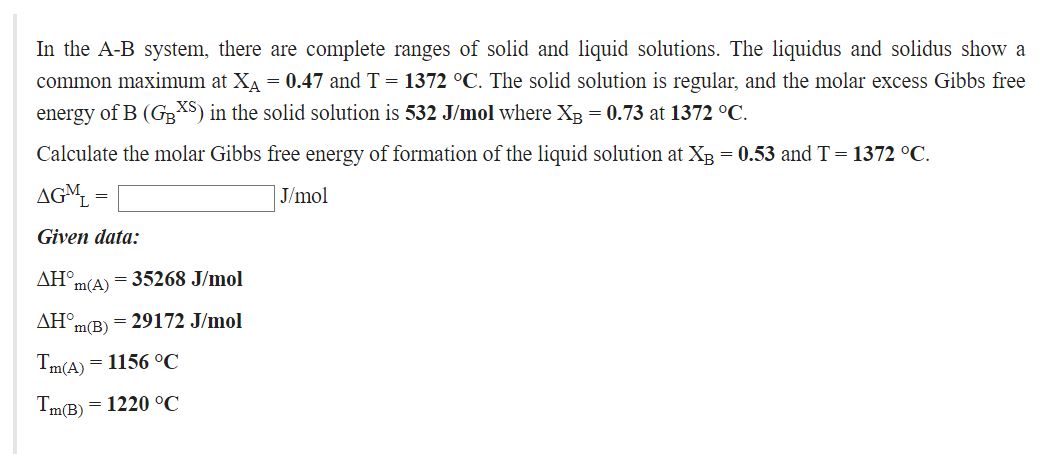Answered step by step
Verified Expert Solution
Question
1 Approved Answer
In the A-B system, there are complete ranges of solid and liquid solutions. The liquidus and solidus show a common maximum at XA=0.47 and T=1372C.
 In the A-B system, there are complete ranges of solid and liquid solutions. The liquidus and solidus show a common maximum at XA=0.47 and T=1372C. The solid solution is regular, and the molar excess Gibbs free energy of B(GBxS) in the solid solution is 532J/mol where XB=0.73 at 1372C. Calculate the molar Gibbs free energy of formation of the liquid solution at XB=0.53 and T=1372C. GLM=J/mol Given data: Hm(A)=35268J/molHm(B)=29172J/molTm(A)=1156CTm(B)=1220C In the A-B system, there are complete ranges of solid and liquid solutions. The liquidus and solidus show a common maximum at XA=0.47 and T=1372C. The solid solution is regular, and the molar excess Gibbs free energy of B(GBxS) in the solid solution is 532J/mol where XB=0.73 at 1372C. Calculate the molar Gibbs free energy of formation of the liquid solution at XB=0.53 and T=1372C. GLM=J/mol Given data: Hm(A)=35268J/molHm(B)=29172J/molTm(A)=1156CTm(B)=1220C
In the A-B system, there are complete ranges of solid and liquid solutions. The liquidus and solidus show a common maximum at XA=0.47 and T=1372C. The solid solution is regular, and the molar excess Gibbs free energy of B(GBxS) in the solid solution is 532J/mol where XB=0.73 at 1372C. Calculate the molar Gibbs free energy of formation of the liquid solution at XB=0.53 and T=1372C. GLM=J/mol Given data: Hm(A)=35268J/molHm(B)=29172J/molTm(A)=1156CTm(B)=1220C In the A-B system, there are complete ranges of solid and liquid solutions. The liquidus and solidus show a common maximum at XA=0.47 and T=1372C. The solid solution is regular, and the molar excess Gibbs free energy of B(GBxS) in the solid solution is 532J/mol where XB=0.73 at 1372C. Calculate the molar Gibbs free energy of formation of the liquid solution at XB=0.53 and T=1372C. GLM=J/mol Given data: Hm(A)=35268J/molHm(B)=29172J/molTm(A)=1156CTm(B)=1220C Step by Step Solution
There are 3 Steps involved in it
Step: 1

Get Instant Access to Expert-Tailored Solutions
See step-by-step solutions with expert insights and AI powered tools for academic success
Step: 2

Step: 3

Ace Your Homework with AI
Get the answers you need in no time with our AI-driven, step-by-step assistance
Get Started


